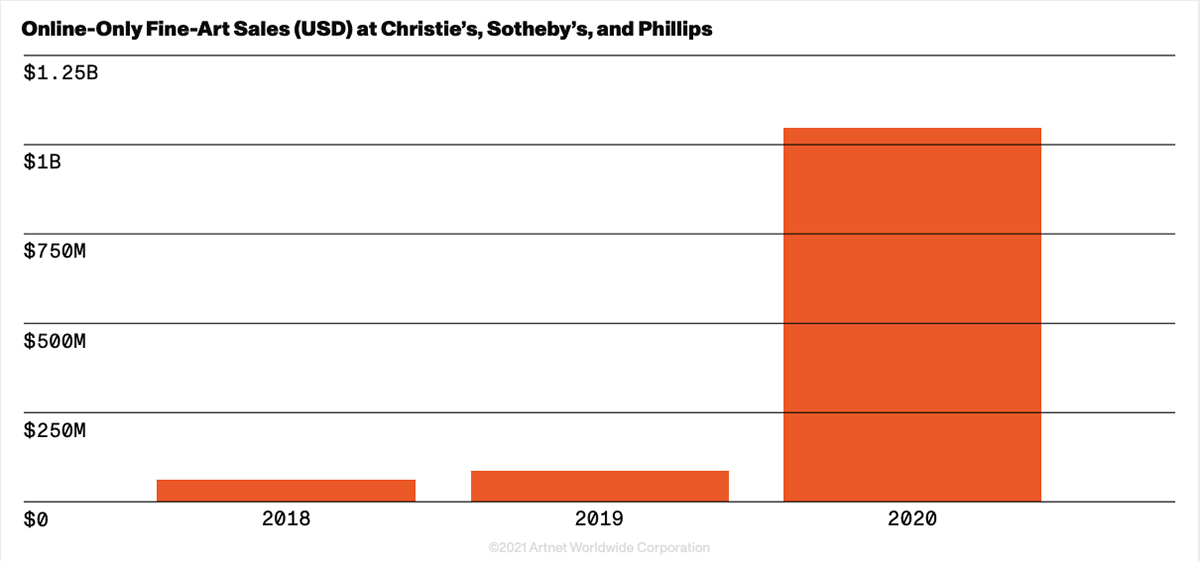
Iceberg Between Paulet Island and the Shetland Islands, Antarctica, 2005 by Sebastiao Salgado
As part on an ongoing monthly column for LUX, artnet’s Vice President Sophie Neuendorf discusses how the art industry can support more sustainable businesses practices which will not only benefit the planet, but also the longevity of art and culture

Sophie Neuendorf
Over the past few months, I’ve been hearing a lot about sustainability and ESG reporting. So much so, that it’s even trickling into the art industry. Perhaps, it can be seen as a positive, global reaction to the pandemic – a way of responding to and making sense of a globally shocking and horrific situation. If the last year has taught us anything, it’s that humanity has abused the planet to such an extent that we’re not only facing a pandemic and the ensuing socio-economic consequences, but also rapidly accelerating climate change. And amongst all of this, a new question has surfaced: how do we preserve our personal and cultural heritage in the face of rapidly increasing climate change, a pandemic, and volatile global socio-economic situations?
Follow LUX on Instagram: luxthemagazine
The arts industry, like any other industry, should be responsible for affecting positive change. Given that arts and culture define us as individuals as well as nations, the arts arguably have an even greater obligation of setting a positive example to safeguard the future of humanity.
When thinking about sustainability, most of us immediately connect it to climate change and the immediate threat to the environment. Of course, this is true and important, but sustainable business practices are not only about the environment. The three pillars of sustainable business practices are the environment, society, and governance (ESG). The idea behind this multi-lateral approach to conducting business is to promote an equitable, efficient, and environmentally progressive business and society.

Horizontal Aspens, 1958 by Ansel Adams
Similarly, the impact of cultural awareness and investment is no longer limited to the traditional sphere of the art market; it has expanded to include political, economical, and environmental activism. The last two years have seen the rise of the MeToo and Black Lives Matter (BLM) movements, drawing widespread support across multiple industries. Corporations with questionable business ethics across the globe were targeted, just as just, equal opportunity, and environmentally-friendly business practices were sought out and celebrated. As the world seeks to slow the pace of climate change, promote equality, and support billions of people, there are several changes we can make now to spearhead the art world’s support for a sustainable planet.
Read more: Durjoy Rahman on promoting South Asian art
At artnet, I used the past year to compile our first ESG strategy and report. By engaging with Environmental, Social and Corporate Governance (ESG) reporting and initiatives, we are hoping to continue our ethos of spearheading positive change and sustainable business practices – our clients expect it of us, and many of our employees are also advocates of change. As a purely digital business, we have already recognised the environmental benefits of transacting online. We don’t, for example, ship artworks across the globe for viewings, require artworks to be viewed in person, have large, costly office spaces, or print thousands of catalogues per sale.

Infographic courtesy of artnet
Elsewhere in the art world, Christie’s recently announced a pledge to become carbon neutral by 2030, making it the first of the major auction houses to do so. The company will focus four main areas to meet its carbon goals, including transforming its processes with shipping, travel, building energy, and printed material. The pledge also commits to a 50% reduction in carbon emissions, which includes diverting 90 percent of its waste away from landfills. They will provide clients with packaging and printed material that is 100% recyclable, and have also made the decision to stop publishing weighty, glossed paper catalogues.
For context, at least 7,000 auctions are held annually around the world with a median of 120 lots per sale (according to artnet price database). For nearly all of them, auction houses print catalogues to send around the world to potential buyers. In an era of digitalisation, print catalogues are unnecessarily destructive for the environment. Moreover, historical auction data is much better safeguarded, and more easily accessible for private collectors, appraisers, or wealth managers on an online database than in a printed catalogue on a shelf. This is just one of many areas of change that could be enacted immediately.

Mentawai Climbing a Gigantic Tree to Collect, 2008 by Sebastian Salgado
5 tips for building a sustainable art business:
- Art businesses should first evaluate their corporations in terms of ESG standards of conducting business and then, establish strategies and targets for the next few years.
- Take steps to reduce your greenhouse gas emissions, which can be direct or indirect emissions. However, it’s important to note that even after significant changes to operations, some emissions will remain.
- The next step is to calculate the remaining carbon footprint, and take responsibility by financially offsetting those emissions. Money can be invested in projects that plant trees or protect forests, support renewable energy programs, equal opportunity initiatives, or other sustainable business initiatives. Carbon offsetting, which is the process of funding emission-reduction initiatives in an effort to “balance out” your carbon footprint, is one step every responsible art business should take as part of its climate action plan. For context, to offset an equivalent amount of carbon to a cancelled coal power station, $300 million worth of trees would need to be planted. With the carbon calculator recently launched by the Gallery Climate Coalition, artists and galleries can make a good estimate at their carbon footprint and clarify where reductions can be made.
- Implement checks and balances for not only the environmental changes, but also the social and governance changes (which affect all stakeholders).
- Make your clients and employees aware of the steps you are taking, and encourage them to join you in this global effort for a sustainable future.
And here’s a final thought: as private collectors, family offices, or businesses, we are often inclined to reduce costs and taxes as much as possible, but I propose the introduction of a voluntary “Green Tax” on the buying and/or selling of art and antiques, which will benefit NGOs working on preserving the environment. Let us forget the short-term gain of wealth accumulation in favour of the long term gain of a greener planet for the next generations.
At the end of the day, it’s up to you to decide how you would like to contribute to a sustainable future, not only for the art industry, but for humanity.
Follow Sophie Neuendorf on Instagram: @sophieneuendorf








